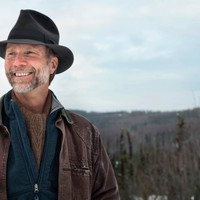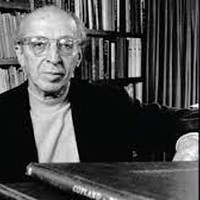Sea, Lake, and Flowing Water Like Rivers


 Listen to Audio
Listen to Audio
Steven Schick and I were having dinner together. I was just beginning work on a large-scale piece for the Seattle Symphony. So when Steve asked me if I might be interested in composing a new piece for The Saint Paul Chamber Orchestra, I must have hesitated.
Deftly, Steve asked me to tell him a little about the Seattle piece.
I went on at length about the music I’d begun to imagine, finally concluding:
“It’s called Become Ocean. The title comes from a poem that John Cage wrote in honor of Lou Harrison.”
Cage observed that the breadth and variety of Harrison’s music make it “resemble a river in delta.” He concluded that:
LiStening to it
we becOme
oceaN.
“So you’re already composing a symphonic ocean,” Steve said. “Maybe for a smaller orchestra you could go ahead and compose that river in delta.”
Steve had me, and I knew it. Within a week I’d begun work on Become River.
From a single high descending line, this music gradually expands into a delta of melodic streams flowing toward the depths.
I now imagine this river and its related ocean, as part of a larger series of pieces encompassing desert, mountain, tundra, and perhaps other landscapes and waterscapes.
John Luther Adams ©2013


 Listen to Audio
Listen to Audio
After studying in France for three years, Aaron Copland returned to the United States with a stark and spiky musical language steeped in Parisian influences. He moved away from those European conventions in the early 1930s, and he soon found his iconic American voice through explorations of local folk music. A campy orchestra work from 1936, El Salón México, brought Copland his first broad success. Two major ballets set in the American West followed: Billy the Kid (1938) and Rodeo (1942). Copland further refined his American style, musically and culturally, with two orchestral works from 1942, Lincoln Portrait and Fanfare for the Common Man.
Copland began his crowning work of Americana, Appalachian Spring, in 1943. The dancer and choreographer Martha Graham asked him to compose a ballet score, with the commission funded by Elizabeth Sprague Coolidge. Copland kept Graham’s style in mind: He saw “something prim and restrained, simple yet strong about her, which one tends to think of as American.” He worked under the title Ballet for Martha until not long before the premiere, when Graham suggested Appalachian Spring, borrowing the phrase from Hart Crane’s poem “The Bridge.” The writer Edwin Denby summarized the scenario for the original program notes:
“A pioneer celebration in spring around a newly-built farmhouse in the Pennsylvania hills in the early part of the last century. The bride-to-be and the young farmer-husband enact the emotions, joyful and apprehensive, their new domestic partnership invites. An older neighbor suggests now and then the rocky confidence of experience. A revivalist and his followers remind the new householders of the strange and terrible aspects of human fate. At the end the couple are left quiet and strong in their new house.”
Appalachian Spring debuted on October 30, 1944, in Washington, D.C. The limited dimensions of the Library of Congress’s 500-seat auditorium dictated a small ensemble, so Copland’s score used just thirteen instruments. Appalachian Spring earned Copland the Pulitzer Prize in 1945, cementing his reputation as the leading composer of his generation.
Copland built the unmistakable sound world of Appalachian Spring mostly out of simple and familiar musical materials. The first section builds a hazy wash of consonant sonorities, especially triads and the open intervals of fourths and fifths. The following section energizes similarly basic materials—octave leaps, triadic intervals and descending major scales—into spry dance music. The scoring emphasizes crisp and brilliant colors, with emphasis on the piano. There is a tender scene for the young couple, a lively romp depicting the revivalist and his dancing minions, and a brisk solo dance for the bride, which dissipates into a return of the gentle, triadic wash of the beginning.
The famous section that follows, starting with a theme in the clarinet, presents the tune of Simple Gifts, a Shaker dance song written in 1848 by Joseph Brackett. The folksy melody fits seamlessly into the homespun, diatonic language of Copland’s score, and the increasingly grand variations build the ballet to its transcendental climax. A prayer-like chorale provides a final coda.
Aaron Grad ©2014
Get driving directions and find nearby parking.
Find dining options close to the venue.
View seating charts to find out where you'll be seating.
Get driving directions and find nearby parking.
Find dining options close to the venue.
View seating charts to find out where you'll be seating.
